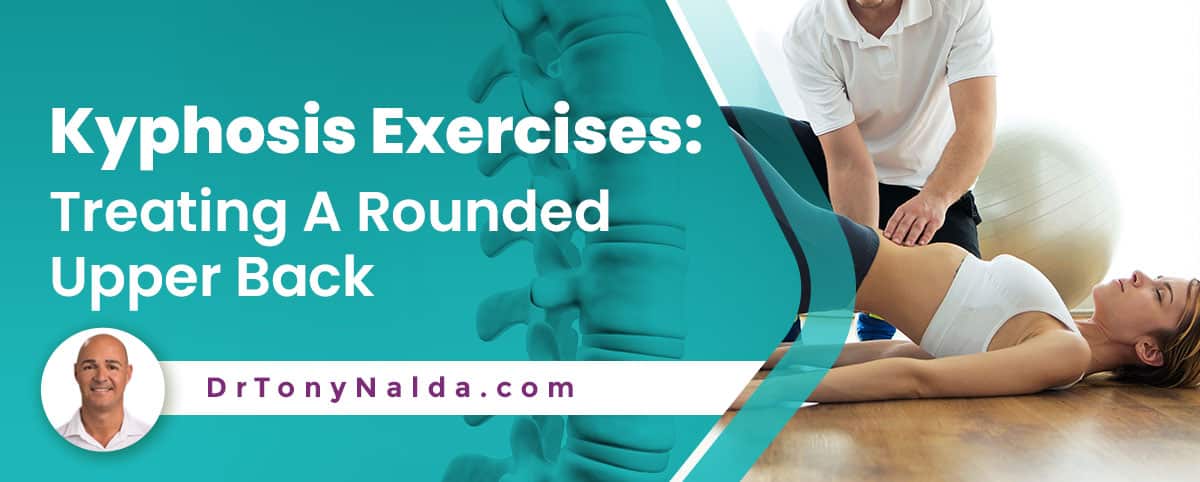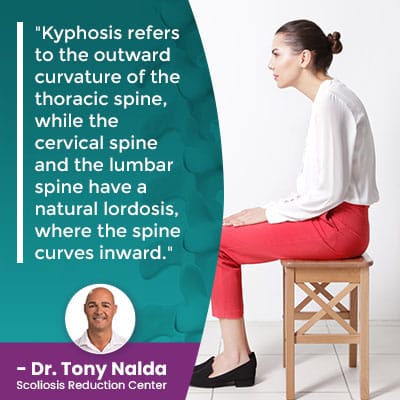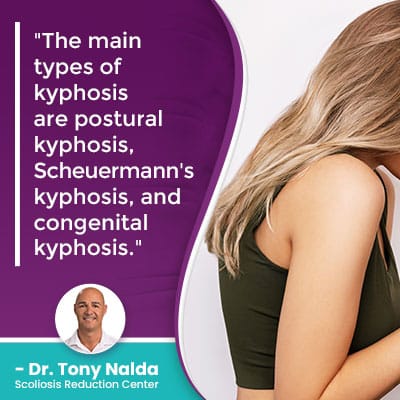Kyphosis Exercises: Treating A Rounded Upper Back

There are a number of spinal conditions that involve a loss of its healthy curves, and sometimes these conditions are structural, and sometimes they are postural. Oftentimes, there are multiple condition types, with varying causes and treatment needs, and this is the case with kyphosis.
The spine's natural curves are key to its optimal strength, health, and function. Kyphosis is a spinal condition that involves an excessive curvature of the thoracic spine, causing noticeably-rounded shoulders.
Understanding why the spine is naturally curved and how those curves factor into spinal health and function is key, so let's start there.
Table of Contents
The Spine's Natural Curves
The spine is naturally curved, which is why when viewed from the sides, it has a soft 'S' shape, but when viewed from the front and/or back, it appears straight.
There are three main spinal sections, and each has its own curvature type: the cervical spine (neck), thoracic spine (upper/middle back), and lumbar spine (lower back).
The spine consists of vertebrae (bones of the spine) stacked on top of one another in a straight and neutral alignment, and when the spine's natural and healthy curves are in place, the vertebrae are aligned, but when an unnatural spinal curve develops, the spine becomes misaligned, disrupting it biomechanics.
Now, even in healthy spines, there can be a range of curvature sizes from one person to the next, but once a curve falls beyond a healthy range, problems can occur, and this is the case with kyphosis.
Kyphosis and Lordosis
The spine's natural curves either curve outwards, away from the body's center, or inwards, towards the body's center.
Spinal curve sizes are measured in degrees, and a healthy range of thoracic kyphosis would fall somewhere between 20 and 45 degrees, with excessive kyphosis, aka hyperkyphosis, commonly diagnosed at 45 or 50+ degrees.
 Kyphosis refers to the outward curvature of the thoracic spine, while the cervical spine and the lumbar spine have a natural lordosis, where the spine curves inward.
Kyphosis refers to the outward curvature of the thoracic spine, while the cervical spine and the lumbar spine have a natural lordosis, where the spine curves inward.
Each section's healthy spinal curvature depends on the health of the others, and as it's not just the spine that maintains its natural curves and alignment, but also the muscles surrounding the spine, unnatural curves also affect muscles in the area.
So when a person's upper/middle back develops excessive kyphosis, the upper back has a rounded forward curvature of the spine that causes a noticeable arch, also referred to as roundback, because the thoracic spine, shoulders, and shoulder blades become noticeably rounded forward.
Now, the causes of kyphosis vary, depending on type, so let's briefly take a look at the different types of kyphosis before focusing on helpful kyphosis exercises and stretches.
The Main Types of Kyphosis
When exploring spinal conditions like kyphosis, it's important to talk about the different types because this is driven by causation, and in order for treatment to be effective, it has to address the condition's underlying cause.
 The main types of kyphosis are postural kyphosis, Scheuermann's kyphosis, and congenital kyphosis.
The main types of kyphosis are postural kyphosis, Scheuermann's kyphosis, and congenital kyphosis.
Postural Kyphosis
Postural kyphosis is the most common type and shows how important good posture can be.
With chronic poor posture, the vertebrae of the spine and their surrounding muscles and ligaments are exposed to uneven forces, which can cause muscles and ligaments to become loose and stretched, and the vertebrae can start to shift out of alignment with the rest of the spine, becoming unnaturally tilted.
As this is a nonstructural spinal condition, the excessive kyphosis is simpler to treat, typically with some lifestyle guidance, education on healthy posture, physical therapy and kyphosis exercises.
Scheuermann's Kyphosis
Scheuermann's kyphosis is a structural condition, meaning it involves an abnormality within the spine itself, and no change of position eliminates the unnatural curve, as it can in cases of postural kyphosis.
For spinal conditions that are structural, a combination of treatment disciplines are needed to impact the condition on different levels; while each case is unique, when it comes to Scheuermann's kyphosis, we're talking about a combination of condition-specific chiropractic care that can impact kyphosis on a structural level, physical therapy and kyphosis exercises to increase strength in the core muscles, with a focus on the upper back muscles, and sometimes, corrective bracing.
Congenital Kyphosis
In cases of congenital kyphosis, people are born with the condition due to a malformation within the spine itself that develops in utero.
If the vertebrae of the upper back and thoracic spine are misshapen in some way, or fail to separate into distinct vertebral bodies, instead becoming fused together, they can form a wedge-shape that pushes outward excessively, causing the development of congenital kyphosis.
So when it comes to treatment for congenital kyphosis, monitoring closely is important, with severe cases receiving surgical recommendations.
So when it comes to kyphosis exercises and stretches, why do they help, and what are they?
4 Helpful Kyphosis Exercises
A healthy exercise routine that focuses on condition-specific exercises, practicing healthy posture, and chiropractic care can help patients improve their kyphosis and roundback appearance.
There have been studies done on the role of exercises for kyphosis in treatment, and findings suggest that when integrated into a proactive treatment plan crafted around causation, exercises that stretch and strengthen can help reduce the angle of kyphosis in the upper back.
While there are many exercises to choose between, and no exercise should be attempted without approval from a patient's treatment provider, the following are 4 helpful kyphosis exercises.
1) Mirror Image
Exercises based on mirror image can be an aspect of treatment in a number of spinal conditions.
When it comes to kyphosis, the idea is that while a patient stands in front of a mirror, they can move in opposition to the posture in need of correction.
This can be done by standing upright and tucking the chin, while pulling the head back into alignment with the torso and sitting evenly between the shoulders.
Next, lowering the shoulder blades to the back and down and holding this position for approximately 30 seconds can help with correcting poor posture and allowing patients to visibly see the difference between proper posture and poor posture.
2) Thoracic Spine Foam Rolling
Thoracic spine foam rolling only needs a foam roller and can be performed easily and safely at home.
This kyphosis exercise involves lying on the floor with a foal roller underneath the middle back while gently rolling up and down on the roller.
This gentle motion massages the muscles of the back and thoracic spine, relaxing them and making them more responsive to treatment, in addition to helping with pain management; it can also help improve mobility of the thoracic vertebrae.
This motion can be performed as many times as is necessary to feel tight muscles loosen, relax, reduce pain, and improve range of motion.
3) Superman Extensions
Superman extensions are spinal extension exercises that target the extensor muscles and can help keep the core muscles loose, strong, and flexible so they can optimally support the spine.
Superman extensions are performed by lying flat on the floor on the stomach and extending the arms in front of the head.
While holding the head in a neutral position by looking down at the floor, lift the arms and legs up towards the ceiling simultaneously.
Holding for 30 seconds and repeating 10 times will create space within the spine, which can counteract compression, while strengthening and stretching the muscles that provide the spine with support and stabilization.
4) Head Retraction Stretch
When there is an unnatural spinal curve in the upper back, it can also affect the neck muscles that can become stretched and weak.
A head retraction stretch involves lying flat on the floor on the back, pull the chin back and into the floor; picture trying to create a double chin.
Holding this pose for 15 seconds with 5 to 10 repetitions can help with kyphosis.
Conclusion
Kyphosis is a spinal condition that can be nonstructural, as in the most common type, postural kyphosis, or structural as in Scheuermann's kyphosis.
Kyphosis is an excessive outward curve of the upper back, and as the thoracic spine's kyphosis becomes excessive, it gives the upper back and shoulders a rounded-forward appearance, commonly referred to as roundback.
Treatment for kyphosis has to be shaped around the type's underlying cause, and here at the Scoliosis Reduction Center, I have treated a wide range of spinal conditions with varying symptoms, severity levels, and types.
The key to preventing kyphosis from getting worse is to address it proactively, and while each case is unique, and there are no treatment guarantees, integrating different forms of treatment can help impact conditions on every level; this commonly involves condition-specific chiropractic care that can work towards manually adjusting the position of an unnatural spinal curve's most-tilted vertebrae back into alignment with the rest of the spine.
Kyphosis-specific exercises and stretches, prescribed by a physical therapist, and combined with other forms of treatment can help with increased pain, improve kyphotic posture, and increase core strength so the spine's surrounding muscles can help support/stabilize the kyphotic spine.
Dr. Tony Nalda
DOCTOR OF CHIROPRACTIC
After receiving an undergraduate degree in psychology and his Doctorate of Chiropractic from Life University, Dr. Nalda settled in Celebration, Florida and proceeded to build one of Central Florida’s most successful chiropractic clinics.
His experience with patients suffering from scoliosis, and the confusion and frustration they faced, led him to seek a specialty in scoliosis care. In 2006 he completed his Intensive Care Certification from CLEAR Institute, a leading scoliosis educational and certification center.
About Dr. Tony Nalda
 Ready to explore scoliosis treatment? Contact Us Now
Ready to explore scoliosis treatment? Contact Us Now





